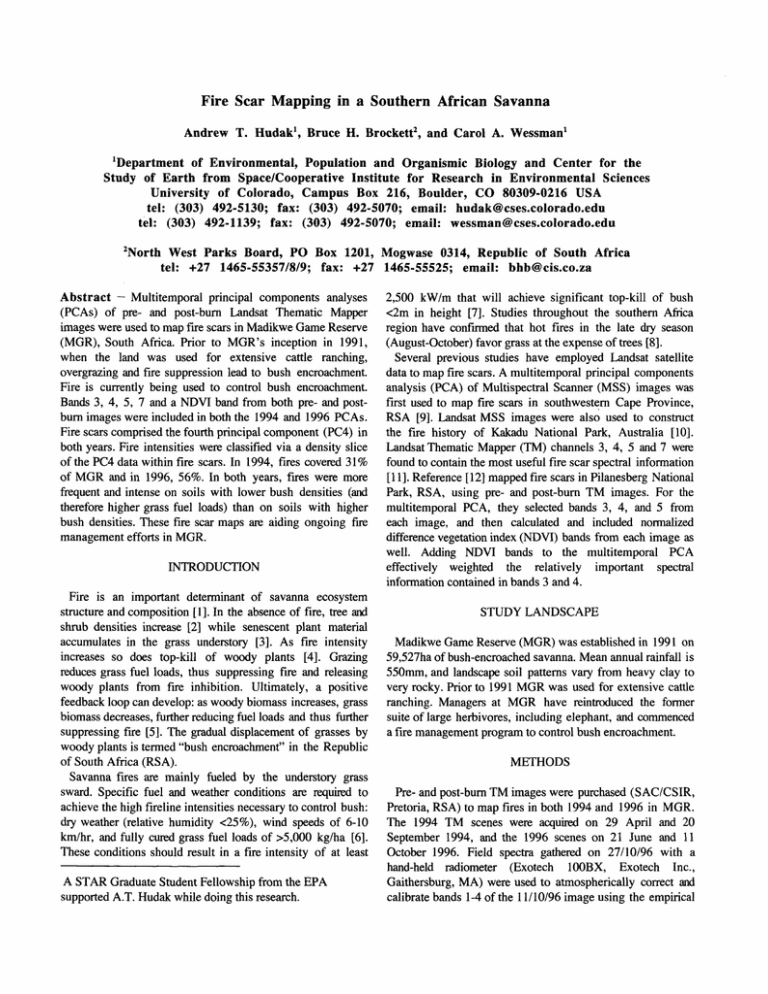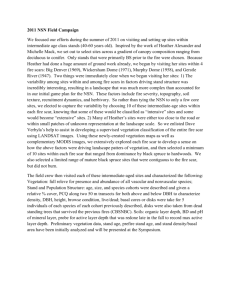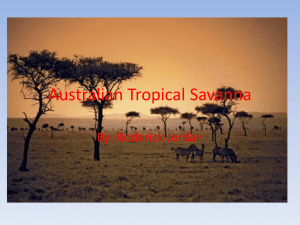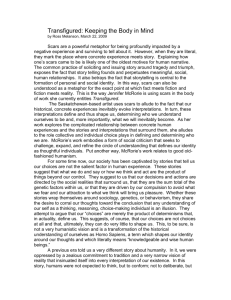Fire Scar Mapping in a ... H.
advertisement

Fire Scar Mapping in a Southern African Savanna Andrew T. ~ u d a k ' ,Bruce H. Brockett2, and Carol A. Wessmanl 'Department of Environmental, Population and Organismic Biology and Center for the Study of Earth from SpacelCooperative Institute for Research in Environmental Sciences University of Colorado, Campus Box 216, Boulder, CO 80309-0216 USA tel: (303) 492-5130; fax: (303) 492-5070; email: hudak@cses.colorado.edu tel: (303) 492-1139; fax: (303) 492-5070; email: wessman@cses.colorado.edu 2North West Parks Board, PO Box 1201, Mogwase 0314, Republic of South Africa tel: +27 1465-553571819; fax: +27 1465-55525; email: bhb @ cis.co.za Abstract - Multitemporal principal components analyses (PCAs) of pre- and post-burn Landsat Thematic Mapper images were used to map fire scars in Madikwe Game Reserve (MGR), South Africa. Prior to MGR's inception in 1991, when the land was used for extensive cattle ranching, overgrazing and fire suppression lead to bush encroachment. Fire is currently being used to control bush encroachment. Bands 3, 4, 5, 7 and a NDVI band from both pre- and postburn images were included in both the 1994 and 1996 PCAs. Fire scars comprised the fourth principal component (PC4) in both years. Fire intensities were classified via a density slice of the PC4 data within fire scars. In 1994, fires covered 31% of MGR and in 1996, 56%. In both years, fires were more frequent and intense on soils with lower bush densities (and therefore higher grass fuel loads) than on soils with higher bush densities. These fire scar maps are aiding ongoing fire management efforts in MGR. INTRODUCTION Fire is an important determinant of savanna ecosystem structure and composition [I]. In the absence of fire, tree and shrub densities increase [2] while senescent plant material accumulates in the grass understory [3]. As fire intensity increases so does top-kill of woody plants [4]. Grazing reduces grass fuel loads, thus suppressing fire and releasing woody plants from fire inhibition. Ultimately, a positive feedback loop can develop: as woody biomass increases, grass biomass decreases, further reducing fuel loads and thus further suppressing fire [5]. The gradual displacement of grasses by woody plants is termed "bush encroachment" in the Republic of South Africa (RSA). Savanna fires are mainly fueled by the understory grass sward. Specific fuel and weather conditions are required to achieve the high fireline intensities necessary to control bush: dry weather (relative humidity <25%), wind speeds of 6-10 km/hr, and fully cured grass fuel loads of >5,000 kglha [6]. These conditions should result in a fire intensity of at least A STAR Graduate Student Fellowship from the EPA supported A.T. Hudak while doing this research. 2,500 kWlm that will achieve significant top-kill of bush <2m in height [7]. Studies throughout the southern Africa region have confiied that hot fires in the late dry season (August-October) favor grass at the expense of trees [8]. Several previous studies have employed Landsat satellite data to map fire scars. A multitemporal principal components analysis (PCA) of Multispectral Scanner (MSS) images was first used to map fire scars in southwestern Cape Province, RSA [9]. Landsat MSS images were also used to construct the fire history of Kakadu National Park, Australia [lo]. Landsat Thematic Mapper (TM) channels 3, 4, 5 and 7 were found to contain the most useful fire scar spectral information [l 11. Reference [12] mapped fire scars in Pilanesberg National Park, RSA, using pre- and post-burn TM images. For the multitemporal PCA, they selected bands 3, 4, and 5 from each image, and then calculated and included normalized difference vegetation index (NDVI) bands from each image as well. Adding NDVI bands to the multitemporal PCA effectively weighted the relatively important spectral information contained in bands 3 and 4. STUDY LANDSCAPE Madikwe Game Reserve (MGR) was established in 1991 on 59,527ha of bush-encroached savanna. Mean annual rainfall is 550rnm, and landscape soil patterns vary from heavy clay to very rocky. Prior to 1991 MGR was used for extensive cattle ranching. Managers at MGR have reintroduced the former suite of large herbivores, including elephant, and commenced a fire management program to control bush encroachment. METHODS Pre- and post-bum TM images were purchased (SACICSIR, Pretoria, RSA) to map fires in both 1994 and 1996 in MGR. The 1994 TM scenes were acquired on 29 April and 20 September 1994, and the 1996 scenes on 21 June and 11 October 1996. Field spectra gathered on 27110196 with a hand-held radiometer (Exotech 1OOBX, Exotech Inc., Gaithersburg, MA) were used to atmospherically correct and calibrate bands 1-4 of the 11110196 image using the empirical line calibration method. Radiance bands of the other 3 images (as well as bands 5 and 7 of the 11/10196 image) were corrected for atmospheric path radiance using the dark object subtraction method, then calibrated and converted into reflectance values. Finally, all four images were georegistered to vector maps from a geographic information system (GIS), using an affine transformation function with nearest neighbor radiometric resampling. Bands 3, 4, 5, 7 and a NDVI band from each image were included in the 1994 and 1996 multitemporal PCAs, performed using ENVI image processing software (RSI, Boulder, CO). NDVI was calculated according to (1): cells. Next, a threshold value was selected from each PC4 image to separate burned from unburned areas. Inspecting image histograms, and comparing the PC4 images to fire distribution maps that had been previously hand-drawn in the field, helped in choosing each threshold. A density slice of the PC4 data on the "burned" side of each threshold was used to classify the fire scars into five intensity classes of equal interval. Finally, using the soil and vegetation layers from the GIS, the proportional area of each of four broad communities occurring within each of the five fire intensity classes was calculated from the 1994 and 1996 fire scar maps. RESULTS NDVI = (band 4 - band 3) / (band 4 + band 3) Fire scars proved to be the fourth principal component (PC4) in both the 1994 and 1996 PCAs. For spatial analysis, PC4 images were transferred into ARCIINFO GRID (ESRI, Redlands, CA). To help conserve disc space and processing time, pixels were aggregated into 100 x lOOm (lha) grid It was determined that 18,231ha (31%) in MGR burned in 1994, compared with 33,213ha (56%) in 1996. Fig. 1 shows the 1994 and 1996 fire scar maps. Figs. 2 and 3 illustrate the proportional area of each of four broad soil divisions occurring in each of five fire intensity classes in 1994 and 1996, respectively. 1994 Fire Scars l9S6 Fire Scars Fire lntensirv Clssses Fig. 1. Fire scar maps of Madikwe Game Reserve, 1994 and 1996 least intense mid-low moderate Fire Intensity mid-high most intense Class Fig. 2. Proportional area of four broad soil divisions found within five 1994 fire intensity classes. Soil divisions represent distinct vegetation communities. least lntense mid-low moderate F m Intensity mid-high most intense Class Fig. 3. Proportional area of four broad soil divisions found within five 1996 fire intensity classes. Soil divisions represent distinct vegetation communities. DISCUSSION Fire intensity classes are more conservative in 1996 than in 1994. Fire scars on the 20109194 post-burn image were highly pronounced because most fires were set only two weeks beforehand. In contrast, more time elapsed between many 1996 fires and acquisition of the post-burn image, allowing time for new grass growth stimulated by the fires to obscure the spectral signature of the fire scars. In addition, higher grass fuel loads and more flammable weather conditions resulted in wider fire distribution and higher fire intensities in 1996 than in 1994. In Kruger National Park, RSA, fire frequencies were found to vary according to vegetation type; rnoistlinfertile savanna burned every 3 years whereas arid/fertile savanna burned every 8 years [13]. In MGR, vegetation on black clay and dolomitic soils is considered moist/infertile savanna, whereas vegetation on loam soils is considered aridlfertile savanna. Vegetation on moistlinfertile soils has a more open physiognomy and, through mutual feedbacks, a higher propensity to bum. The fact that more moistlinfertile savanna intensely burned in both 1994 and 1996 is corroborating spatial evidence for a higher fire frequency on black clay and dolomitic soils. The utility of satellite imagery for mapping fire intensities requires further research. One possibility that is being pursued is to use color infrared (CIR) digital aerial photography to sample a number of fire scar sites. The higher resolution CIR images will be classified into fire intensity classes based on ash hue and patterning; these classes will then be used to calibrate the Landsat TM image-derived fire intensity classes. CONCLUSION Landsat TM imagery was successfully used to map fire scars in MGR. These 1994 and 1996 fire scar maps are helping ecological managers assemble a fire history and plan future fire management strategy, which will be important for determining the long-term effect of fires on woody overstory structure and composition in MGR. ACKNOWLEDGMENTS We thank the U.S. EPA and North West Parks Board for supporting this project, Fanie Ferreira at SAC for supplying data, and Mark Thompson for image processing advice. REFERENCES [I] W.S.W. Trollope, "Fire in Savanna," in Ecological Effects of Fire in South African Ecosystems, P. de V. Booysen and N.M. Tainton, Eds. Berlin: SpringerVerlag, 1984, pp. 149-176. C.G. Trapnell, "Ecological results of woodland burning experiments in northern Rhodesia," J. Ecology, vol. 47, pp. 129-168, 1959. F.J. Kruger, "Effects of fire on vegetation structure and dynamics," in Ecological Effects of Fire in South African Ecosystems, P.deV.Booysen and N.M.Tainton, Eds. Berlin: Springer-Verlag, 1984, pp. 2 19-243. W.S.W. Trollope, "Controlling bush encroachment with fire in the savanna areas of South Africa," Proc. Grassl. Soc. South. Afr., vol. 15, pp. 173-177, 1980. D. Graetz, "Grasslands," in Changes in Land Use and Land Cover, W.B. Meyer and B.L. Turner, Eds. Cambridge: University Press, 1994, pp. 125-147. A.W. Bailey, B.H. Brockett, and M.T. Mentis, "Fire management in Pilanesberg National Park, Bophuthatswana, using expert systems as aids to decision making," African Journal of Range and Forage Science, vol. 10, no. 1, pp. 25-30, 1993. W.S.W. Trollope and N.W. Tainton, "Effect of fire intensity on the grass and bush components of the Eastern Cape Thornveld," J. Grassl. Soc. South. Afr., vol. 3, pp. 37-42, 1986. W.J. Bond, "Fire," in Vegetation of Southern Africa, R.M. Cowling and D.M. Richardson, Eds. Cambridge: University Press, 1997, pp. 421-446. M.W. Thompson, "Mapping of the December 1988January 1989 fires in the SW Cape using multitemporal LANDSAT MSS data," Forestek Internal Report FOR 16, Sept. 1990. J. Russell-Smith, P.G. Ryan, and R. Durieu, "A LANDSAT MSS-derived fire history of Kakadu National Park, monsoonal northern Australia, 198094: seasonal extent, frequency and patchiness," J. Applied Ecology, vol. 34, pp. 748-766, 1997. M.C. Pereira and A.W. Setzer, "Spectral characteristics of fire scars in Landsat-5 TM images of Amazonia," IJRS, vol. 14, no 6, pp. 2061-2078, 1993. M.W. Thompson and E.R. Vink, "Fire scar mapping in Pilanesberg National Park," External CSIR contract Report ENVlPlCl97157, August 1997. B.W. van Wilgen and R.J. Scholes, "The vegetation and fire regimes of southern-hemishereAfrica" in Fire in Southern African Savannas: Ecological and Atmospheric Perspectives, B.W. van Wilgen, M.O. Andreae, G.J. Goldamrner, and J.A. Lindesay, Eds. Johannesburg: Wits University Press, 1997, pp.27-46.





